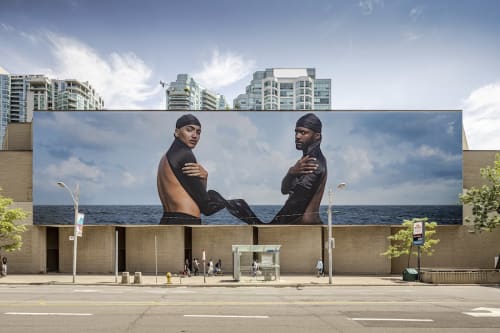If you’ve walked past Queens Quay and Bay lately you’ve probably seen Esmaa Mohamoud’s piece for Contact Photography Festival, The Brotherhood FUBU (For Us, By Us).
It’s hard to miss and that’s intentional. The sprawling image is on the largest outdoor banner in Canada, spanning 37 by 144 feet.
Two figures in a body of water stand apart from each other while connected by a twin-headed durag. Their piercing gazes look out over their shoulders and down at us, commanding attention. Is it defiance in their eyes? Or is it assuredness? Perhaps it’s the unspoken certainty that they deserve to take up all this space.
“There’s an exchange that’s happening with the viewer,” said Mohamoud in a phone interview. “It’s very hard to escape their gaze, like no matter where you’re walking on that street, those eyes follow you. The power dynamics really change once you blow up bodies to that scale.”
The way that Black masculinity is simultaneously hyper-visible and invisible was front of mind for Mohamoud when conceiving the piece. Black male identity is stereotypically portrayed as threatening, hard and aggressive. It’s a lazy and racist depiction that flattens it, stripping it of nuance, rendering a more genuine multitude of representations invisible.
The former NOW cover star is known for sculptures that explore these ideas intimately, considering all the limitations that work to control and pigeonhole Black people – keeping them in a position to be continuously extracted from. She often does this through the lens of professional sports, industries that are largely built on the labour of Black players to the benefit of white owners.
Shortly after the piece was unveiled in June, Mohamoud brought her father to see it.
“It was a big moment, because my father has never seen Black people represented in this way and he’s never seen my work this large. As soon as we got out of the car, it started pouring but he was so excited he just stood in the rain and enjoyed the piece.”
Shortly after the piece was unveiled in June, Mohamoud brought her father to see it.
“It was a big moment, because my father has never seen Black people represented in this way and he’s never seen my work this large. As soon as we got out of the car, it started pouring but he was so excited he just stood in the rain and enjoyed the piece.”
His desire to look longer and take it all in aligns with Mohamoud’s intention to create an image that shows a kind of Blackness that feels authentic to Black people. Even though thousands of people will see this over the two years that it will be displayed, she is speaking directly to her community.
“[It’s about] seeing Black people represented how we want to be represented, rather than how we’ve been represented by others.
The two figures in the image are friends of Mohamoud’s and fellow artists, Noah Brown and Timothy Yanick Hunter. Over the years she’s had countless conversations about Black masculinity with them both. When deciding who she wanted to photograph, she was looking for Black men in her life that had left an indelible effect on her.
A sculpture meant to accompany the mural has been delayed until late 2022 because of the pandemic. It’s a two-headed durag like the one worn by Brown and Hunter in the image, cast in bronze with a black finish. One side of the sculpture is designed to look as if neatly laid cornrows are just below the surface of the durag and the other side has waves, a hairstyle that involves brushing out curly hair and setting it so it resembles the ripples of water.
Keeping your hair intact with a durag is a quintessential marker of Black masculinity. You do it for yourself but also to be in communion with the other people who will appreciate the painstaking detail and time put into maintaining the hairstyle.
Elsewhere in the city, Mohamoud has another public work on display. The Bentway’s Summer of Play programming runs until September 27 and incorporates a number of interactive installations.
Dribble Dribble is Mohamoud’s surreal re-imagining of a basketball court, one without any of the rules that can be a hindrance to accessibility. The multicoloured vinyl court lines are jumbled up and run over each other, the chain mail nets are all at varying heights and different sizes, from five feet to six inches wide.
“I wanted people to come play basketball, but I wanted them to make up their own rules. So many people feel like things are inaccessible to them because of the ways that rules are structured. Like, ‘I’m not tall enough to play basketball.’ Well, what if we put a net much lower? Would you want to play then?”
The focus is on playing for joy rather than to win, to create a space for people of all ages to come together and have pure fun.

